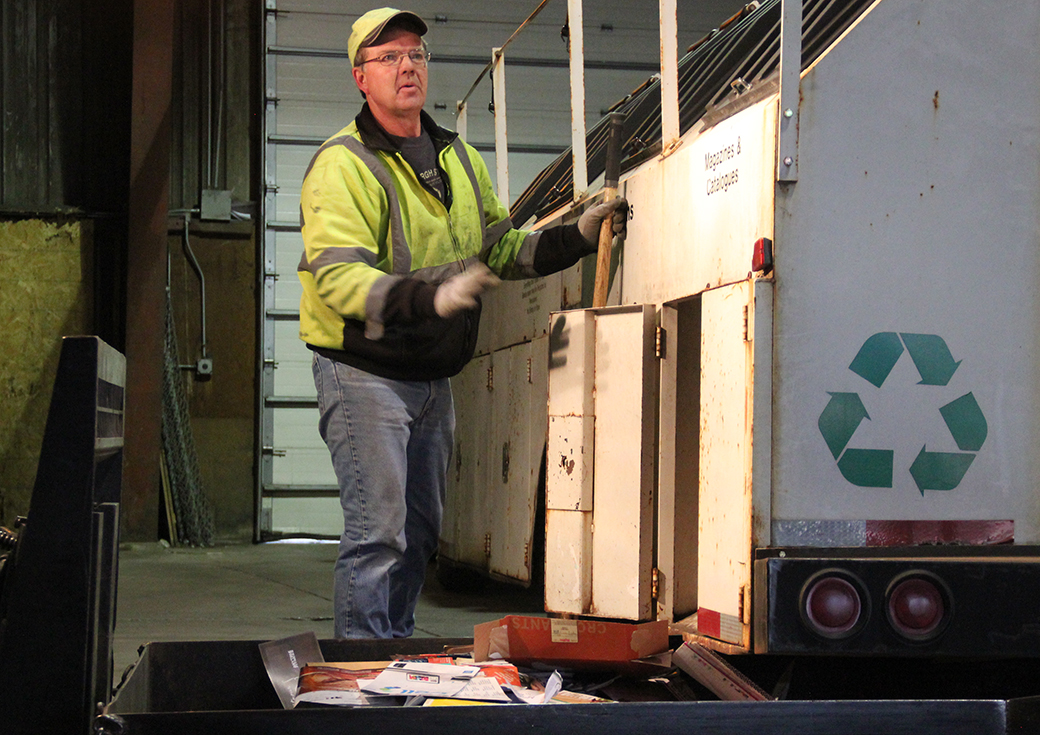
Recycling at USD decreased from 2013
Every other weekend, University of South Dakota first-year Gabbie Sefranek, a sustainability major, takes seven peoples’ worth of recyclables back to her hometown of Omaha, Neb.
“None of my friends would recycle before I asked them to,” Sefranek said.
Sefranek’s mother teaches at a high school where the janitors take all recyclables to a center that pays 5 cents per item. That money is then given to families in need.
Sefranek believes USD should have more locations for students to drop recyclables off, which would encourage more students to recycle. But Director of Housing Todd Tucker said student involvement regarding recycling throughout USD housing isn’t strong.
“In all honesty, there hasn’t been a ton of student passion in the recycling world in housing, and generally that’s what helps those programs get off the ground a little bit — to have students get involved and take full advantage of what we do have to offer,” Tucker said.
USD Housing recycles paper, cardboard, plastic and aluminum cans. Some residence halls have recycling on every floor, but most don’t have the room for the containers.
Tucker said each building has at least one central recycling area. There is also a trash compactor located between Coyote Village and McFadden Hall.
Another obstacle housing encounters is contamination, because the Missouri Valley Recycling Center in Vermillion won’t take those items.
“A lot of times, students throw garbage in those (recycle bins),” Tucker said. “We don’t have the time or capability to pick through every single recycling area on campus.”
For a more consistent recycling system, Tucker said a bigger push would have to come from students or the new President’s Joint Committee on Sustainability, which is still appointing members. Once it officially meets, the committee will consist of students and faculty.
Bob Iverson, director of solid waste and recycling with the city of Vermillion, is in charge of the landfill and Missouri Valley Recycling Center.
The recycling center has received more than 135,000 pounds from USD so far this year, Iverson said. At this time last year, Iverson said they had received 200,000 pounds, which he said may be because USD recycled a lot of textbooks last year.
Tucker said education, marketing and containers that look the same from building to building would boost that amount.
“What it is going to take is kind of where it’s starting right now, and that’s a push from the president to know that this is very important to students and it’s something that everybody on campus needs to look closer at and be a part of,” Tucker said.
Iverson said nationwide the recycling market is down and difficult to make a profit in.
“Right now, recycling is in the red,” Iverson said. “It usually is.”
Vermillion’s recycling center has a curbside program for most residential homes and drop-off trailers located at the Vermillion High School and Vermillion Middle School, Ace Hardware and Pump N’ Pak.
Curbside recycling started in 2009. It is not currently offered at larger apartment buildings or any trailer parks, but Iverson said that may be an option in the future.
Recycling costs $3.30 per month for homes and $10 per month for businesses. Residents don’t have to participate, but are automatically billed for the service by the city.
Iverson said the center recycles about 2,000 tons of product each year. The facility serves Clay and Yankton County.
“They’ve always been good at recycling. When you compare the two towns that we work with, we get a lot more recyclables in than Yankton does,” Iverson said. “There’s just more people here that are involved with recycling.”
Iverson said USD has a big part in how much Vermillion residents recycle because “they’re pushing it more.”
In addition to the standard aluminum, plastics and paper, the center recycles shoes, paint, books, clothes and is able to dispose of used needles.
Scrap metal, tires, wood and electronics are recycled at the landfill.
Glass is one of the few materials the center no longer recycles. Because it has to be crushed, particles get in the air, which results in a need for costly safety equipment. If any of the crushed glass is contaminated, it is rejected and has to go to a landfill.
Regardless, Iverson said bringing glass back to the facility is being considered.
“It’s not going to make money, it’s going to cost us money,” Iverson said. “But it’s something people are wanting, so we’re looking at it.”
Other than glass, number three through seven plastics are not accepted at the center because there’s currently no market for them, Iverson said.
Every year, the recycling center hosts a hazardous waste pickup in Vermillion and Yankton, usually in September or October. This pickup allows residents to get rid of what Iverson said shouldn’t go in the landfill, like batteries, light bulbs, gasoline and other chemicals.
In total, the annual waste pickup costs the recycling center $30,000, because a company has to come in and deliver the materials across several states.
Because the center is city-operated, Iverson said he doesn’t think they’ll have to stop taking certain products.
North Complex is one building Sefranek thinks needs a more green focus.
“People just toss (recyclable items) away because it’s easier,” Sefranek said.
Whether on campus or not, Sefranek said anything that can be reused or recycled should be.
“I just don’t understand why not,” Sefranek said. “Why not do it if it’s right there and it’s really easy to do.”
(Photo: The Missouri River Valley Recycling Center has received more than 135,000 pounds of items from the University of South Dakota. At this time last year, the recycling center had received 200,000 pounds of items. The center, which serves both Yankton and Clay counties, recycles a total of about 2,000 tons of products per year. Ally Krupinsky / The Volante)


